This trip report will be my report on flying Malaysia Airlines economy class from Kuala Lumpur KUL to Senai (Johor Bahru) JHB, a short-haul domestic route within peninsular Malaysia, as well as my visit to both KLIA and KLIA2 public area. This report will be slightly heavier on Kuala Lumpur KUL as I had an overnight stay at the airport followed by a rather short flight.
Background
Being uninterested the prospect of slumbering in my bedroom for the long weekend, I initially decided to head to Malacca and Kuala Lumpur (again) for the long weekend and ended the trip by flying Malaysia Airlines to Johor Bahru before proceeding back to Singapore, which I had not tried before. However, since I had to get my colleagues to assist with the preparation for an event, I decided to cut Malacca from my itinerary and went only to Kuala Lumpur, especially to travel at some places I did not get to go during my previous trips.
Through my colleague's suggestion to go within peninsular Malaysia from Johor Bahru (Larkin) by bus to significantly cut down on travel cost, I had this plan for my trip:
Singapore - Johor Bahru (Larkin): Public bus
Johor Bahru (Larkin) - Kuala Lumpur (TBS (Terminal Bersepadu Selatan; southern intercity bus terminal)): Intercity bus
Kuala Lumpur (TBS) - Kuala Lumpur: Private car (especially since it's midnight)
Kuala Lumpur (KL Sentral; integrated transport hub) - Sepang (KUL): Airport bus
Sepang (KUL) - Senai (JHB): Plane
Senai (JHB) - Johor Bahru (JB Sentral; integrated transport hub): Airport bus
Johor Bahru (Sultan Iskandar checkpoint) - Singapore: Public bus
While the plane trip is on the pricier side at close to RM 90 (US$20) after travel agent discount compared with my previous trip on Malindo, the bus trip to Kuala Lumpur is a very reasonably priced one at only RM 35 (US$8). With Malindo exiting from the Kuala Lumpur KUL - Johor Bahru JHB route, this is hands down the best one can get for short-haul, intra-peninsular Malaysia route (except that for a fee you can get a hot meal on AirAsia but not on Malaysia or Malindo).
Travelling to and in Kuala Lumpur
Since I met my friend on the afternoon at Tanjong Pagar, I decided to start my trip from Queen Street Terminal (near Bugis) using Causeway Link, especially considering that it has the fastest travel time among all other options with high frequency bus across the Causeway and nonstop trip between Queen Street Terminal and Woodlands Checkpoint. The immigration experience was bad at Woodlands Checkpoint with a rather long queue, although it was nothing compared with Sultan Iskandar checkpoint with its 1-hour long queue to the point even the whole arrival hall was full and some people from behind started shouting. That was especially the case since Sultan Iskandar checkpoint has less automated gates and manned counters, further exacerbated by the fact that a lot more people in Singapore use automated gates than they do in Malaysia.
I then decided to travel to Kuala Lumpur with Causeway Link, as my experience on the past trip with them was not that bad. I bought my ticket at Larkin terminal, which although I could not get promotions from online travel agents, it also made sure that I only bought the ticket when I have safely arrived at Johor Bahru considering the immigration queue. I then spent my time at around the checkpoint area before returning to Larkin terminal for my bus trip. Since before I reached Malaysia I checked that the bus would be rather empty, the fact that the bus was quite full showed that there are also a lot of last-minute travelers taking the trip. The travelers are also mostly Malaysian since people from Singapore have their own bus services to KL which are more convenient but also much more expensive.
Photo of the bus bringing me to Kuala Lumpur

The bus looked rather acceptable for the trip, and considering that bus services from Singapore won't be that much better yet significantly more expensive, I would consider the fare a steal.


The bus encountered some traffic jam at Johor state, therefore I only managed to arrive at Kuala Lumpur (TBS) at 2 AM instead of 1 AM. The arrival area was not that small, and all are equipped with escalator, which was appreciated.



I did not get to cover the terminal much as I needed to save my phone battery (more of the terminal can be seen on my previous report), but one observation that I made was that a one-way bus ticket from Kuala Lumpur (TBS) to KLIA would cost me RM 11 (US$2.5), more than the RM 10 (US$2.2) fare had I went from Kuala Lumpur (KL Sentral). Even though admittedly TBS is way nicer than the dingy KL Sentral's bus terminal, I would prefer not to make a detour solely for the terminal's comfort.


Instead of sleeping at the terminal (TBS), I booked the cheapest possible place to stay, which to some extent did not suit me that well.
During the day, I went to several places I did not get to visit during my previous trips to Kuala Lumpur. Here are some of the photos:
I got my soymilk and tau fu fa at this stall, which was very near from my hostel at Chinatown. I somehow miss the latter since it was so rare I even consider it a delicacy (and by the way, the stall itself is quite famous, see here)

Afterwards, I went to KLCC to check if they have student prices for the concert that afternoon by Malaysian Philharmonic Orchestra to compare against Singapore Symphony Orchestra which concert I attended two days before, although I was disappointed to find that only public price for higher tier seats are available and therefore scrapped my plan.
Located a short walk away from Kampung Baru station, despite its banner showing it as a seafood restaurant, apparently it served mixed rice with Malaysian/Indonesian dishes. To make it even better, they also serve urap, one of the dishes I miss more as well. Highly recommended if you are looking for value for money Malaysian style lunch. Find out more about the restaurant here.

Supposedly taken towards the west direction since I could barely identify the buildings there.

Viewing KLCC, apparent from the distinctive Petronas tower and other towers nearby.

Facing Bukit Bintang area as seen from Berjaya Times Square (the large brown coloured building). I stayed at that region for my previous trip.

KL Sentral area, touted as Kuala Lumpur's newer CBD, is just around St. Regis (the all-tinted glass building at background). KL Sentral station was not visible behind, being blocked by St. Regis and other buildings around.

The looming bad weather called me to continue my trip.

Since it was on a long weekend, even going down from KL Tower took me some time with the queue occupying half the observation deck.

The KL Tower entrance

The store opposite the entrance provided a much cheaper package to visit KL Tower, which I did not know until I waited there for my taxi to come.

KL Tower drop-off area, which was rather crowded due to rain.

Aesop at KLCC. I went there as I had somehow run out of their products, and I found that their prices compared with branches in Singapore are quite much lower at around 20% discount, so I would not hesitate to travel there for my larger purchases.

Kuala Lumpur KUL KLIA2 public area
As I had heard of KLIA2 before (even my parents flew from there as well), especially its purportedly extensive retail offering at the public area, I decided to go to KLIA2 by bus, which cost me RM 1.50 (US$0.3) from KLIA. The bus terminal was acceptable, although still a far cry from TBS.


I then checked the rate for shower at Capsule by Container Hotel, which was RM 25 (US$ 5.3) with free towel, toiletries, and mineral water. I decided not to have a shower there, especially due to the high fare (but Plaza Premium lounge nearby charged even more than that at RM 32 (US$7.2), so it's still quite a deal for discerning travelers).

As I arrived quite late at night, some stores had already closed, but judging from the interior itself it didn't look that shabby. It also have some reasonably-priced supermarkets tailored for travelers, which unfortunately close on 12 midnight,
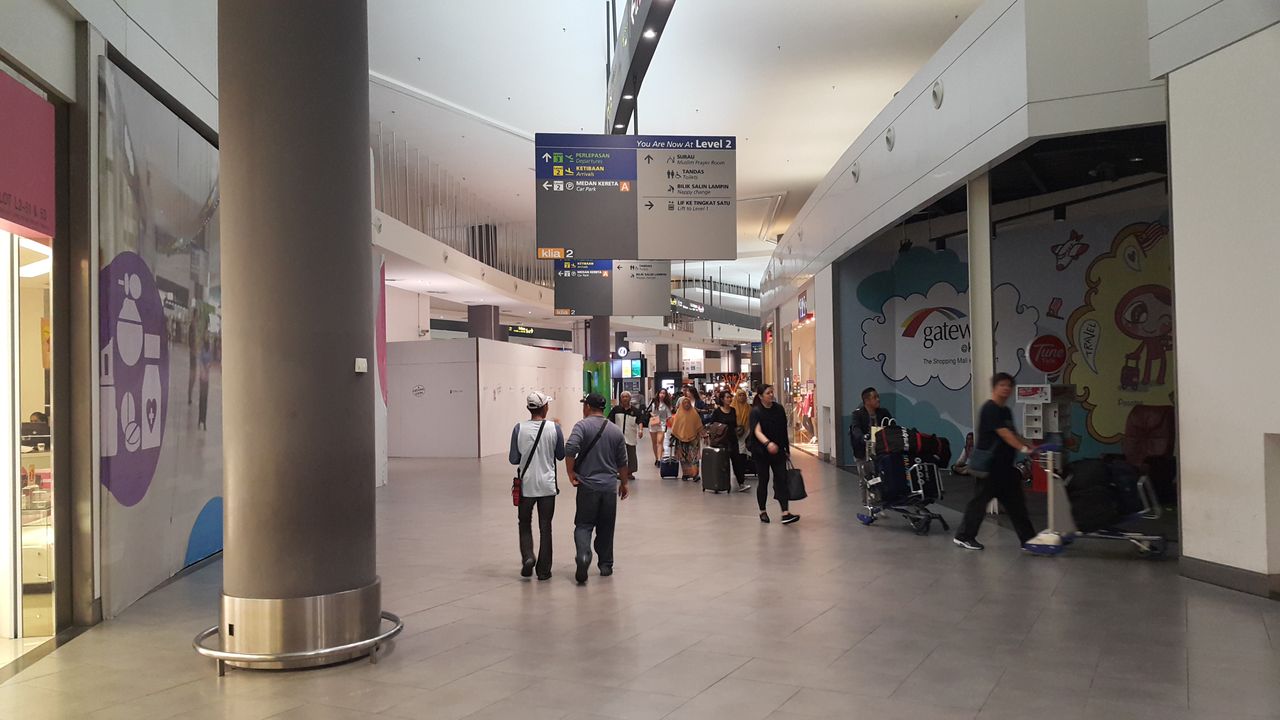
They even have a printer to allow people do web check-in there instead of at the main kiosks at the departure area. Nice try, though.

Have you ever felt coming to a terminal thinking it would be a slightly less walkable one? I think this is one of the few times I've felt that. The terminal was quite big even they have an estimated walking time indicator.


Flying AirAsia X? Good luck walking up to 20 minutes - especially as I understand the widebody gates are only available on pier P/Q.

Thinking of trying some Indonesian food at KLIA2? Prepare to pay a hefty price for it - I could stuff myself silly back in Indonesia at the same price.

Some of the more famous Indonesian foods. I somehow found the Bumbu Desa at KLIA2 quite different from what they have back in Indonesia with their heavy focus on set menu - or is it just my feeling?
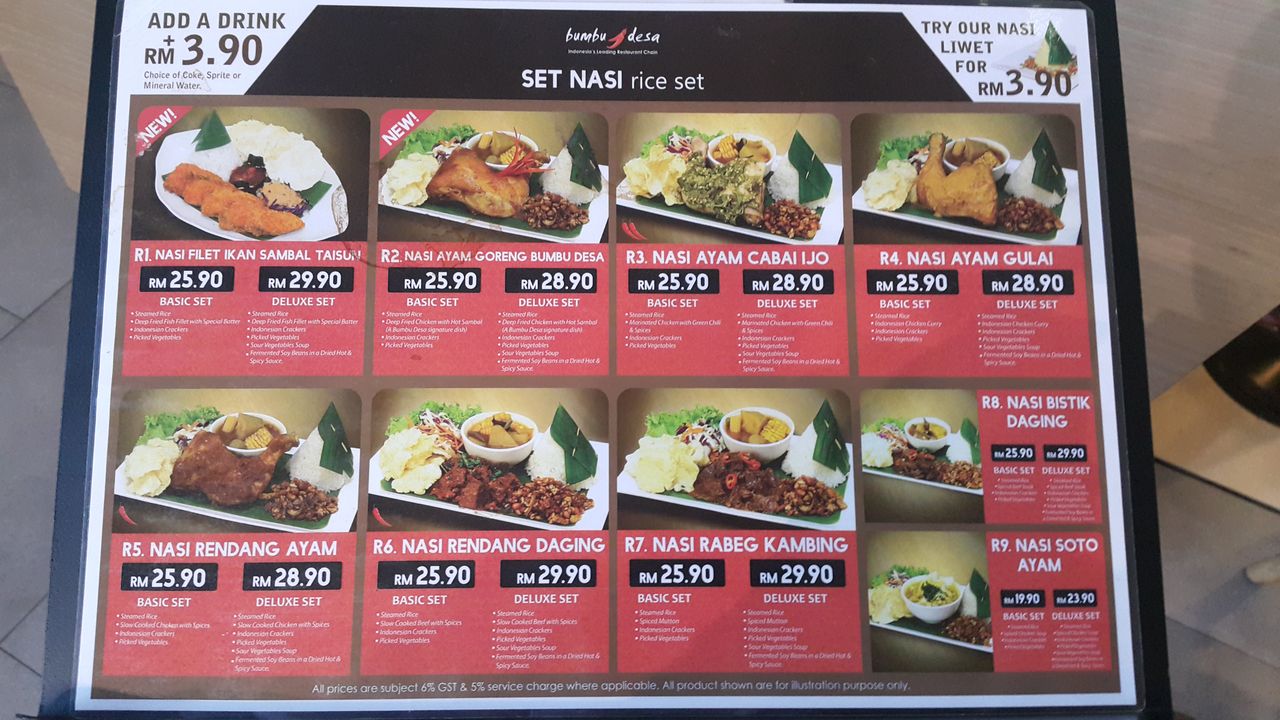

For every check-in island there are around 8 self check-in machines.

Bag drop counters are separated for different destinations. Here is one of the counters for the row designated on flights to Indonesia

One of the counters for the row designated on flights to Indochina, which once made some Indonesians think of it as Chinese invasion of Indonesia (see here for the news).

Several counters are equipped with self bag drop counters, possibly aiming to reduce the number of staff.

As I needed a shower, I then asked the information counter for the free shower (why bother with paid shower when you got all you need to shower?) Here is how to go:
From the domestic departure area (left side of the check-in area, closed due to no midnight departure):

Proceed to the walkway between the minimarket and a food stall

Find the male (or female) lavatory

Done! Immediately after entering the lavatory, look at the left side to find the shower cubicles. The shower cubicle has only one hook and no place to store toiletries (try hanging yours on the tap handle, but my cubicle's tap handle went off I put my toiletries on the floor instead), making it necessary to be slightly more creative on putting your clothes and toiletries. I also could not find somewhere to store my bag and shoes safely, so I decided to leave my bag and shoes in front of my cubicle. The shower cubicle was not the cleanest and only have cold water available, but for what it's worth it's still a fully functional, free shower.
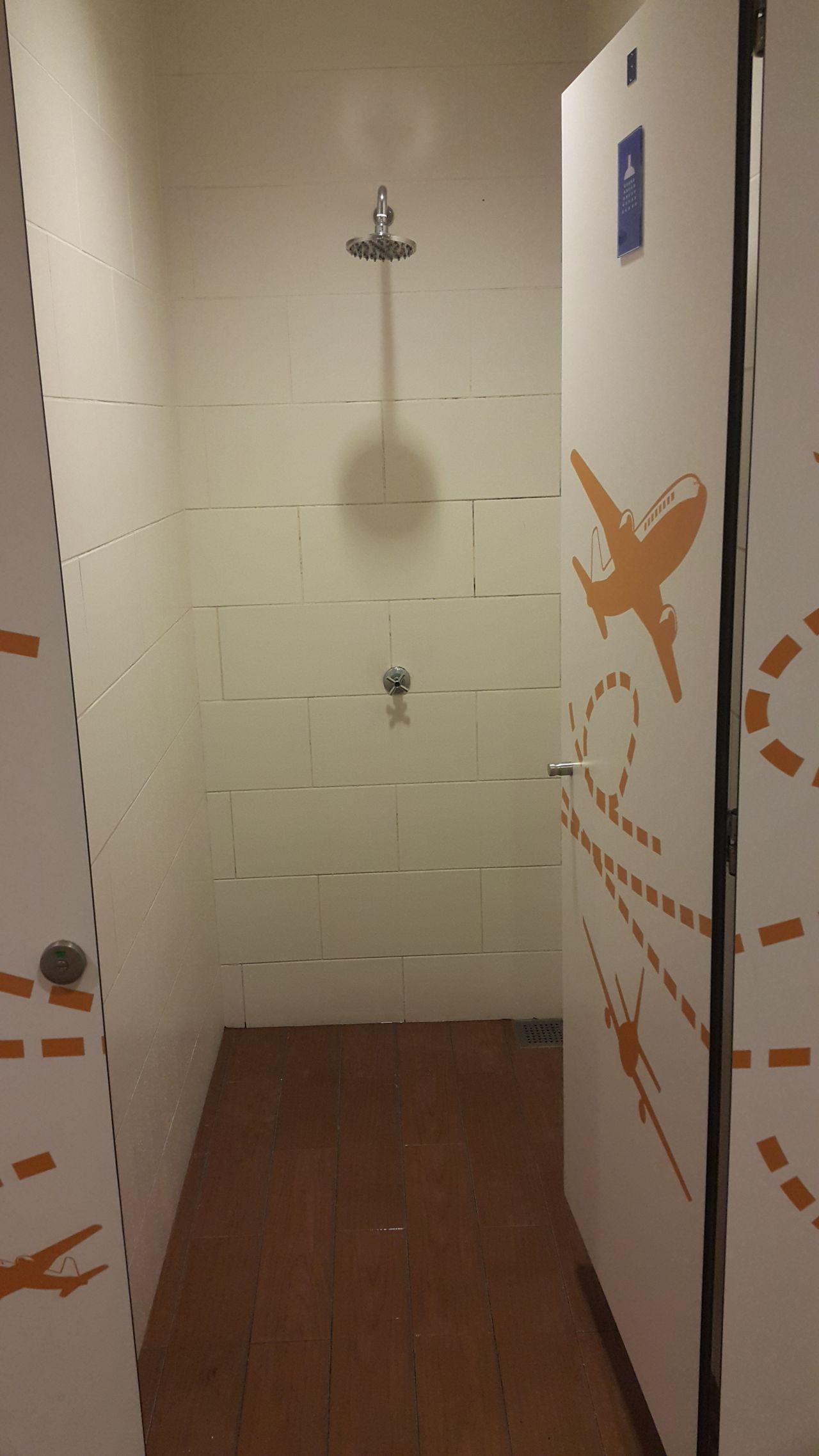
As my flight will leave at main terminal, I decided to try KLIA Ekspres train for my interterminal trip. The ticket only cost me RM 1.8 (US$0.4) after my self ticket purchase discount, so I consider it to be more worth it than taking bus back to main terminal. You are technically only allowed to take KLIA Transit for interterminal trips, although taking KLIA Ekspres is also not prohibited as unlike at KL Sentral they share the same entry/exit gantry. One notable difference for tickets purchased at the manned counter and at self service counters or online is that the ticket at manned counters are in form of a card and must be surrendered upon exit from the gate at the last trip, while the ticket bought using machine or online are using QR code which will be scanned on entry and exit.
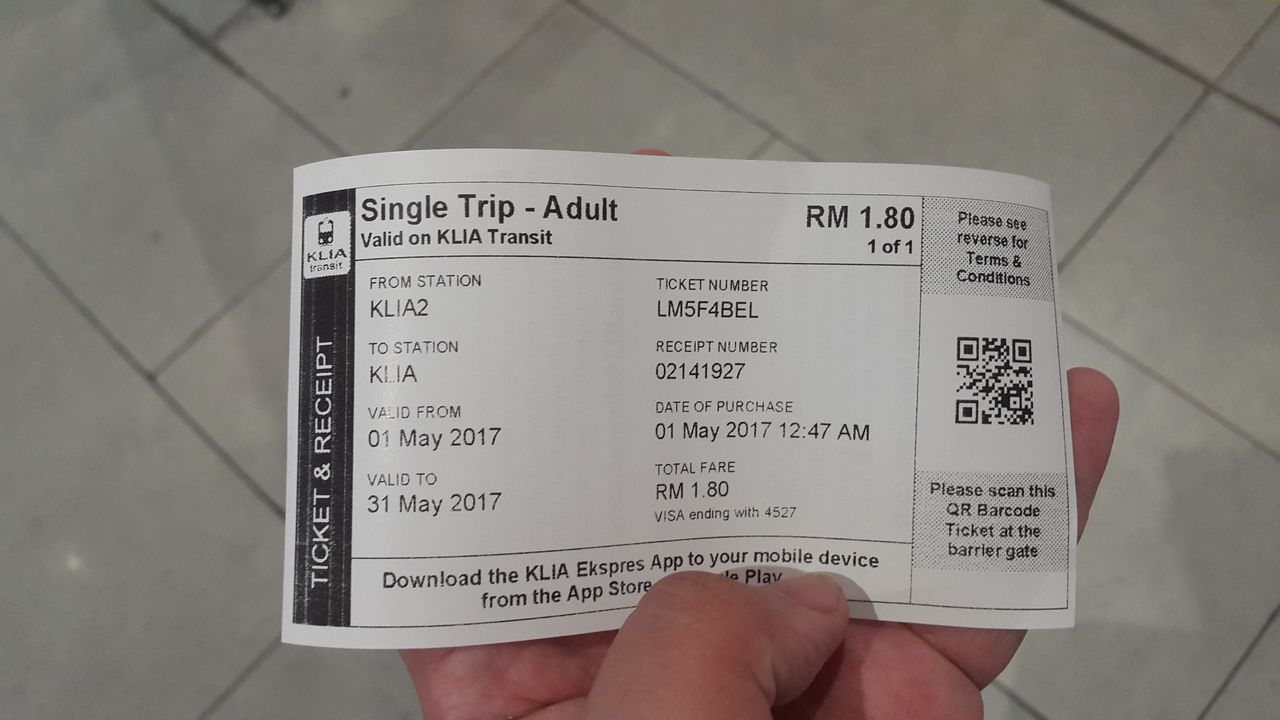
Being a premium transport mode to go to Kuala Lumpur, the train station is far more prominent than the terminal bus.
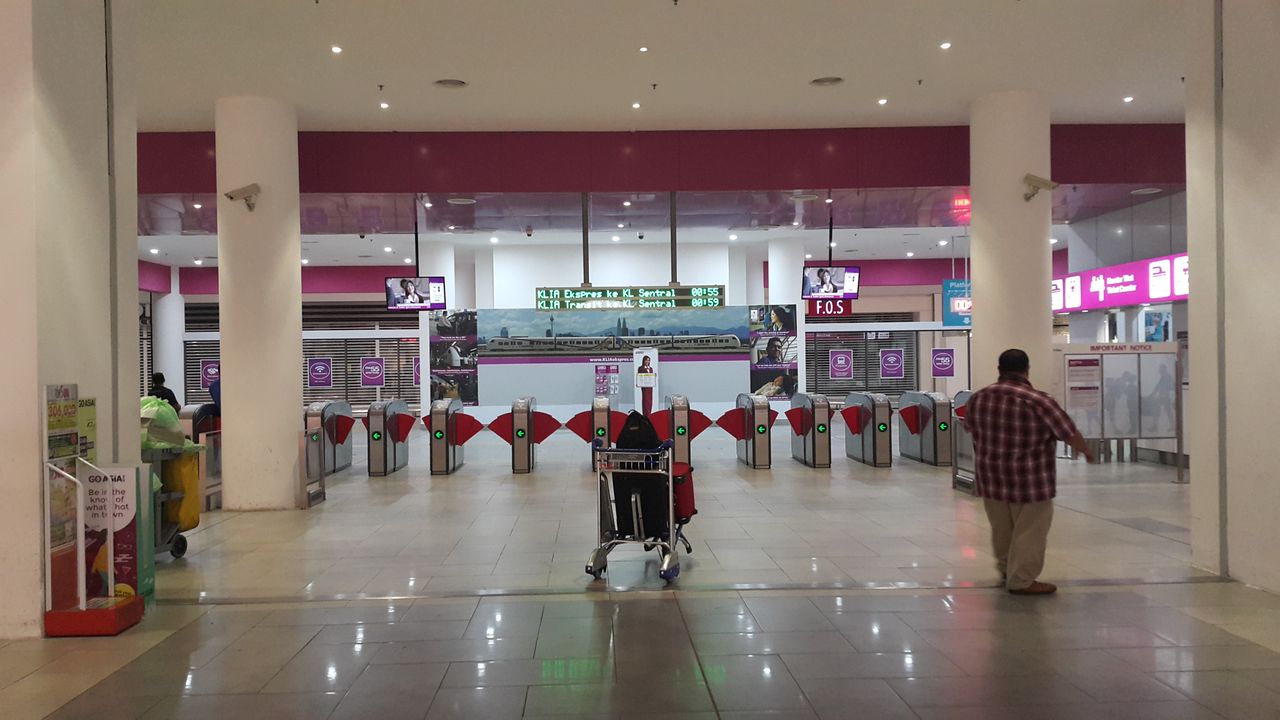

The platform was separated for the two train services, although they share the common waiting area.

The last KLIA Ekspres train to KL Sentral via the main terminal has arrived. The last KLIA Transit train to KL Sentral would follow in a few minutes.

Interterminal trip within Kuala Lumpur KUL, Kuala Lumpur KUL KLIA public area, and check-in
As I entered the train, one of the main things I notice is the luggage rack. While on KLIA Transit there are only overhead luggage racks, this is one of the distinguishing features of the express train.
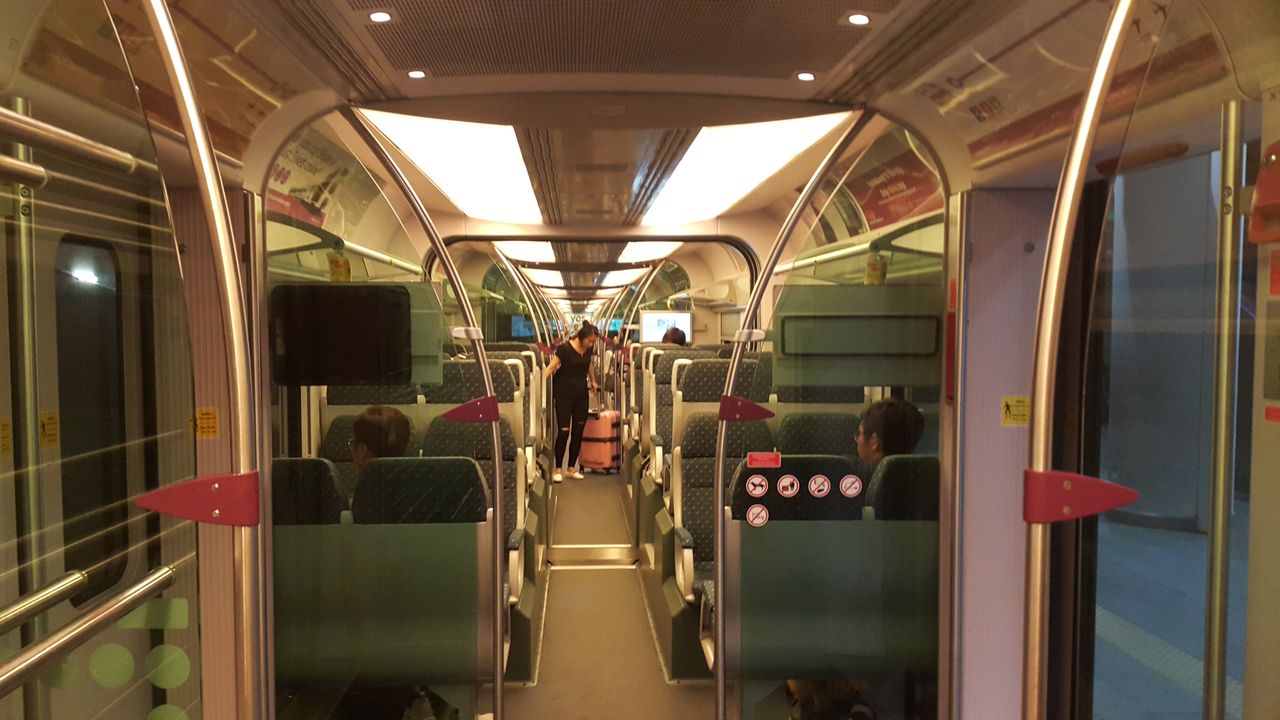
The seats are the same as the ones at KLIA Transit, which was uncomfortable as they are non-reclinable and hard, and not deserving the premium price tag.

Legroom was acceptable as the seats are very basic and quite thin.

They even feature a broken cup holder, but not AC plug to charge my mobile phone. Does that constitute a premium service?

Last glimpse of KLIA2. I'll see you on my next visit to Kuala Lumpur KUL.

Guess what's missing on the train door compared with KLIA Transit (given up? Answer before conclusion)

The train station at the main terminal seem well-appointed compared with the one at KLIA2 with platform screen doors and fully enclosed, air-conditioned platform.

KLIA Transit vs KLIA Ekspres: only the stops and luggage racks are different.

KLIA Transit seem to be more popular with people going to TBS/Putrajaya.

I have reviewed this terminal as well on one of my other trip reports - check it out here.
The main terminal has 5 floors on/above the ground (i.e. no basement), which is quite a lot compared with other airports.


When was the kiosk first put into service? Even the start screen looked like it was made very long ago.

Before check-in, I saw this upgrade advertisement. One thing they did not mention was whether the rate would be discounted, which is quite fishy.

I then proceeded with check-in, producing my identity and mobile screenshot of my FFP number at a Oneworld member with hope of getting some miles. I then checked for the rate for the upgrade, after which the officer checked a card with small writings behind the badge and quoted RM 360 (US$83). Since I could not submit my upgrade bid offer on MHupgrade (Malaysia's brand for its online upgrade bidding using the system made by Plusgrade) and the upgrade fee was rather exorbitant for such a short flight, I decided to stay in economy class. The check-in process itself was fast as there were no queue and I got away with my (still economy class) boarding pass. Even though I mentioned before that Malaysia Airlines required all economy class passengers from Kuala Lumpur KUL to do self check-in, I still got the usual full-service check-in at the manned counter. Is their own rule just a gimmick, or else …?


My boarding pass in Malaysia's more proper boarding pass stock. Even though I had a ticket ticketed by Malaysia (e-ticket number starting with 232), marketed by Malaysia (MH flight number) and operated by Malaysia (flying on actual Malaysia plane) as required to bid for the upgrade online, I somehow was not eligible to submit it.

Malaysia seem to have a lot of ticket counters at the airport. Catering to last minute passengers, perhaps?

Malindo now has a more proper setup for their business class check-in with carpet and counters closer to the drop-off area.

Malaysia's self check-in machines look rather bulky compared with AirAsia's.

Feeling slightly bored, I tried reprinting my boarding pass using the kiosk, which looked terrible compared with the boarding pass given during check-in at the manned counter.

Qatar's flight attendants preparing for the trip back to Doha DOH

As I became slightly hungry, I decided to go to the Indian/Malaysian food stall at the bus terminal. I then ordered fried rice and a glass of teh tarik, which in total costed me only RM 9 (US$2) and tasted quite acceptable. Quite recommended if you can take Malaysian/Indian foods, especially due to the lower price than at the food court.


Passport and boarding pass check area leading to the international departure.

Area behind the check-in desks, which are not that bad to sleep (except at the new seats with curved seat bottom).
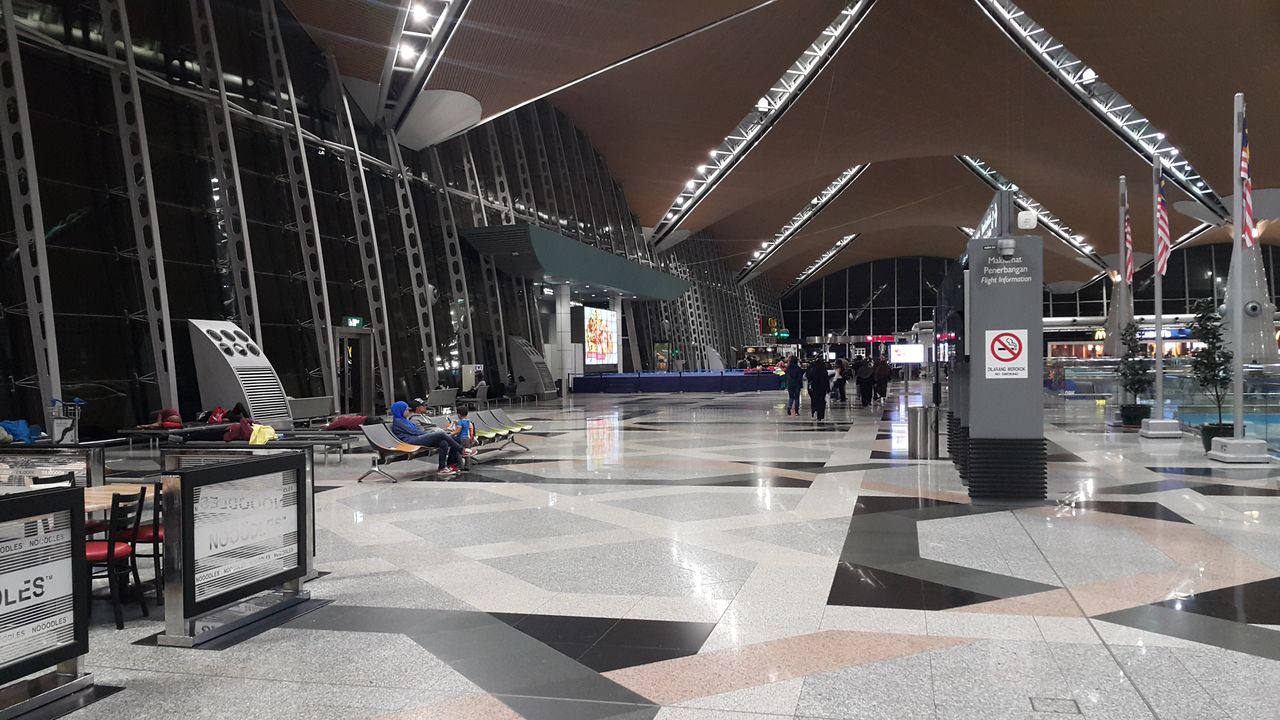
Viewing gallery, which would be only open at 6 AM so I needed to skip it


The shops at the check-in area has yet to open as it was still early.

As there seem to be quite many flights in the morning, the check-in area was crowded. Had only I opted to check-in later….

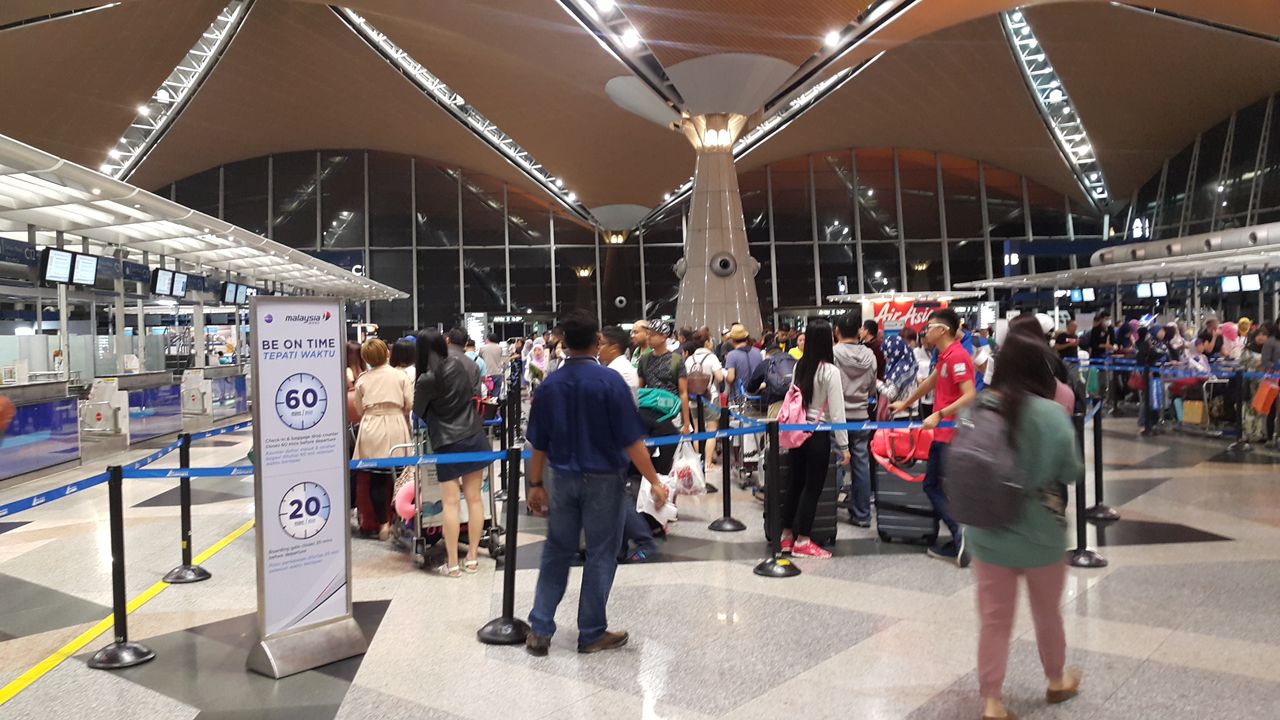
Garuda's check-in counters at row A, which was not too crowded.

Security for the domestic departure was hassle-free.


Back to the luxury stores again - in the morning? On domestic departure area?


It's going to be a slightly long walk.
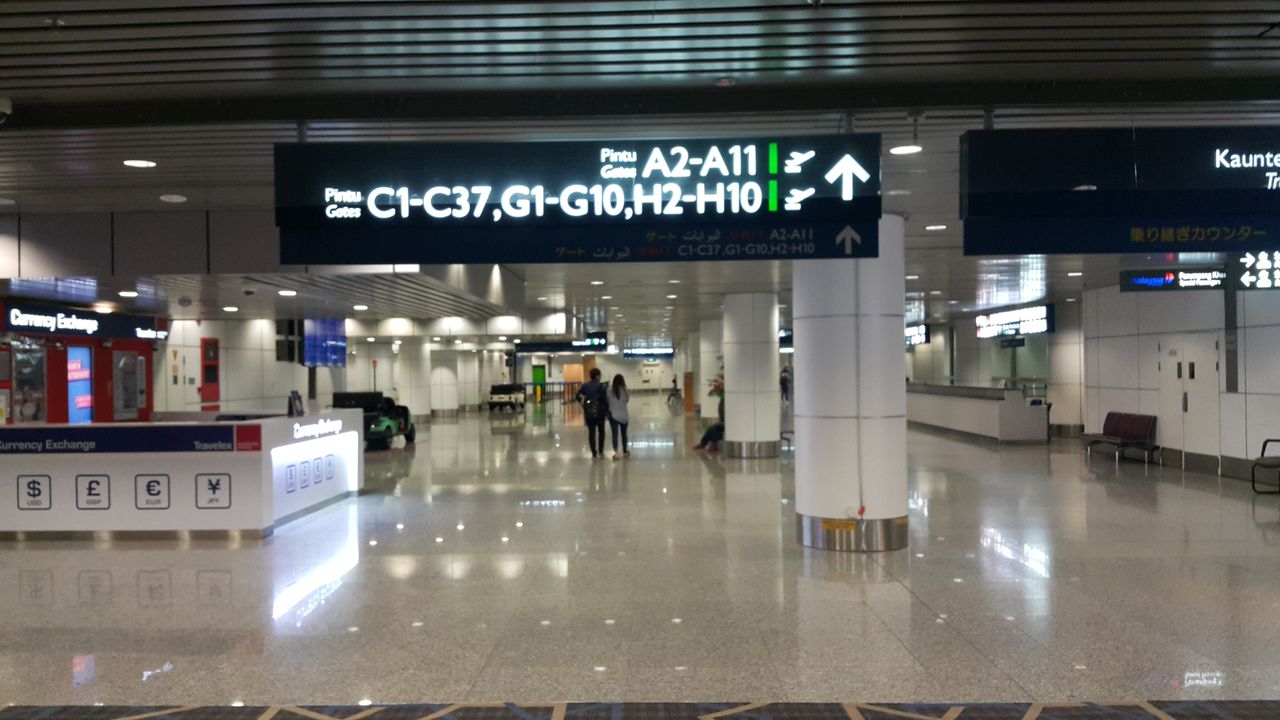
Domestic to international departure immigration area, which was quite quiet as there are very few, if any, flights arriving.


As the day had just started at Kuala Lumpur KUL domestic departure area, the airport seem very quiet.


I then simply waited at my gate (A5) while charging my phone and working on my deliverable.


The plane, 9M-MXC, taking a rest before the day started.
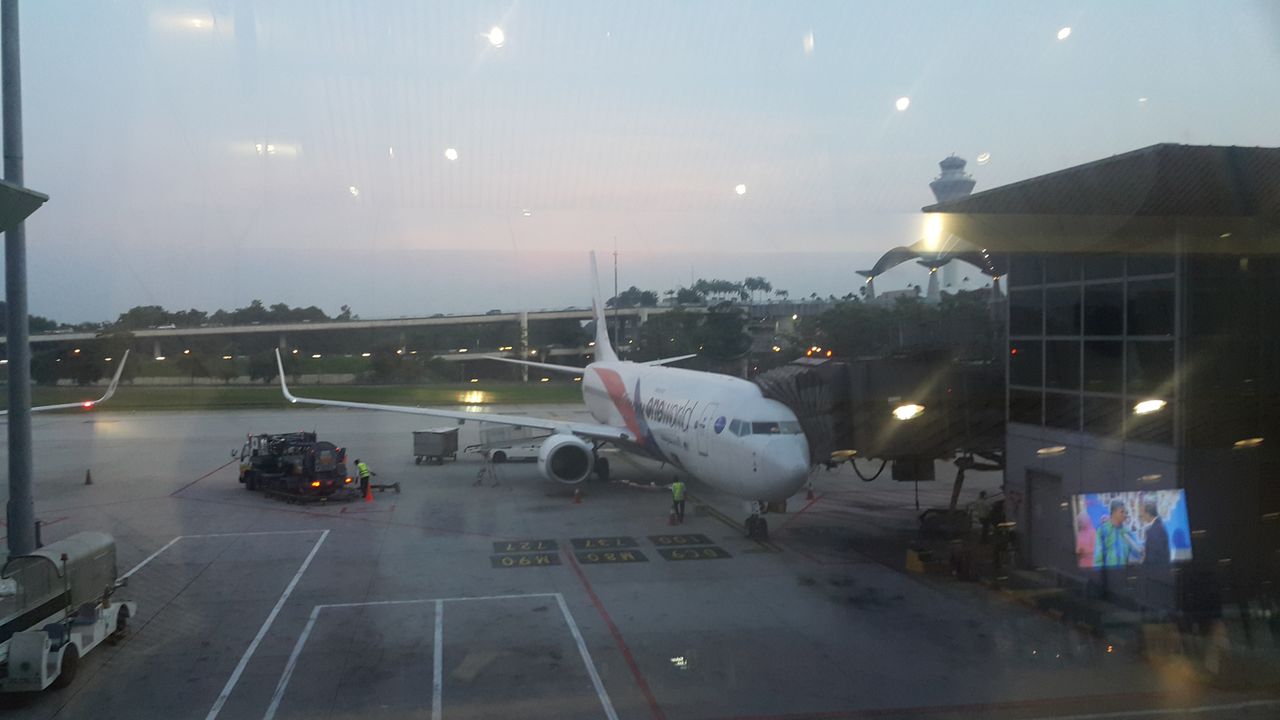
Soon, boarding was called, which was quite fast. I then checked with the gate agent for the load of the flight, which he said as 35 in economy and 2 in business class; not the heaviest load indeed. I then proceeded to the plane and saw the special livery the plane bore.


On board
Flight: MH1037
Plane: 9M-MXC (Oneworld/Malaysia Airlines livery)
STD/ATD: 07.20/07.33
STA/ATA: 08.10/08.11
Load factor: 13% C (2/16), 23 - 25% Y (35/144 - 150)
Seat type: Standard economy class (configured in 16C 144Y/16C 150Y)
Details: https://www.flightradar24.com/data/flights/mh1037#d3d59e7
Upon boarding, a selection of newspapers were available. I took The Star, a Malaysian newspaper in English, which was more decent than Malindo's Malay Mail.
After passing the business class cabin, I got to see the economy class seats, which looked like LCCs with its leather seat and colors.

For some reason, Malaysia's 737-800 seem to be heavy on regional business class by SE Asia standard, considering that it's still not as premium as Singapore.
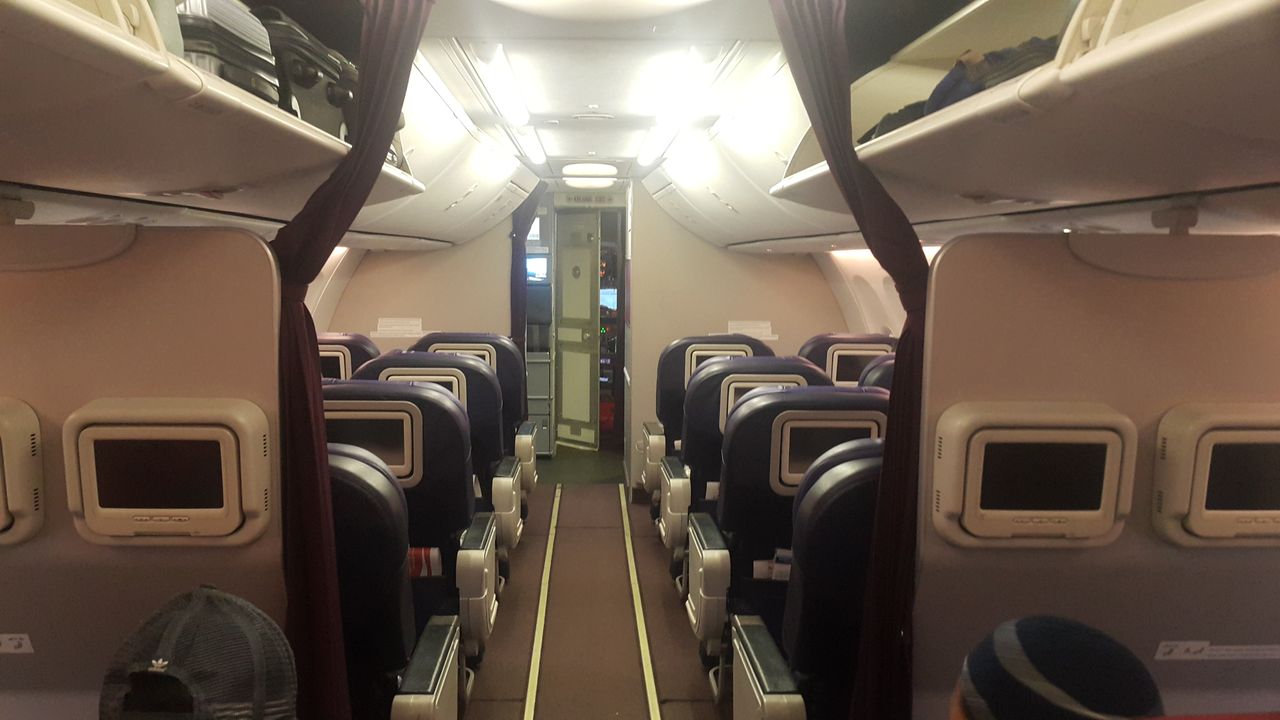
Seat pitch was bad at only 30", and unlike Malindo's ATR72 they only have the literature pocket at the lower part of the seat to store the safety instruction and other booklets, which made the legroom worse. IFE boxes are also found in every seat, which ensured an equally abysmal experience for all, compared with some airlines that combine the boxes under only one seat. If Malindo as a hybrid LCC can do better than this, is Malaysia turning to a low cost, high fare carrier? On the bright side, however, they provide 2 power plugs for every 3 economy class seats, which was quite appreciated.

The IFE looks quite a bit like Garuda's, and they also have USB plugs to charge your portable devices. Unfortunately, I found the remote difficult to take out on some seats, rendering it almost useless had it not for the touch-unresponsive screen they have.
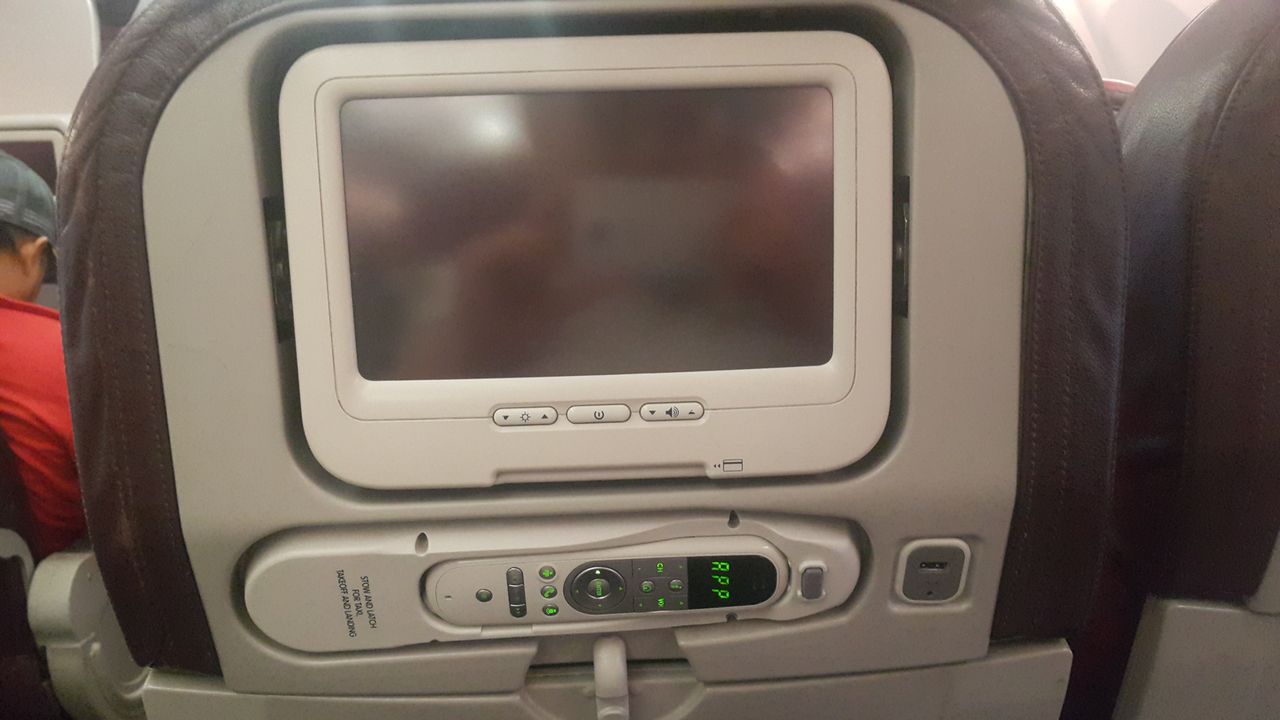

Inside the seat pocket were the usual stuffs: safety card, in-flight magazine, in-flight shopping directory (which admittedly was very thin), and Malaysia-branded airsickness bag.




As the plane departed from concourse A, during taxi we got to see the satellite terminal before we took off from runway 32R. Interestingly, instead of departing from the runway end, we entered from one of the taxiways at the middle of the runway, apparently to save time.
KLIA2's famous bridge viewed from our cabin:

Malaysia's flagship, Airbus A380, parked at the satellite terminal.

After we took off, the meal of the day was served, which consisted of a small package of salted peanuts and 95 ml orange juice with Malaysia-branded serviette. The salted peanut was acceptable despite the slight lack of crunch, while the orange juice tasted decent (unlike the very sweet Malindo's orange drink on mainline flight or mineral water for the feeder flight) although definitely on the much smaller side. I could not take the photo during the service as when I tried to take the photo the flight attendant asked me not to take photo of them.

So I am going from Malaysia to Singapore, and now I have a drink produced in Singapore? Interesting point.

I then went to the toilet, which was acceptably clean especially due to the flight being the first one for the plane. However, the plane was in need of some refresh, especially considering the sad state of the flush button.


After my short toilet visit, I then asked the flight attendant about the flight's very low load factor. She mentioned that the flights were usually full on working days, therefore signifying Malaysia's positioning as a premium carrier in Malaysia, being popular among businessmen. With my fare being almost twice as much as AirAsia's fare, I then also got to understand that people would usually rather fly to Kuala Lumpur SZB instead due to the shorter distance from downtown area, proven by the very high load factor on my flight to Kuala Lumpur SZB.
I moved to seat 10F so I could take some photos from outside. Unfortunately, I also found the IFE remote control for the seat to be challenging to remove, and now I got to see the seat 10D having the stitches for the seatback pocket broken. From the photo you could also see that Malaysia's 737-800's seats can be considered as fully featured slimline seats.

View during the cruise:

Soon after, during descent one of the flight attendants went to my seat while bringing a continuous paper which I presume to be the manifest for the flight. She then first asked me where I was going to (Singapore via Johor Bahru) and where I am studying, citing that she is from Johor Bahru and her relative is also in Singapore. Afterwards, she then followed up with why did I take photos during the flight and ask the flight attendant, noticing that she saw me doing the toilet visit, and even asked if I was a journalist, which I found slightly unique. She also reminded me that taking photos on board a Malaysia Airlines flight is actually prohibited and although the crew was fine on it, she warned me to get the crew's permit to take photos before doing so on other occasions, the exact opposite of the KLM crew on my flight a few months ago who even asked if I would like to have my photo taken on my seat. While apparently they may be on the slightly more paranoid side due to the major incidents, I don't think it would be the right attitude to handle the issue.
We soon approached Johor Bahru JHB.



The landing was quite acceptable, and we soon get to see the airport terminal, which is quite near to the runway.

We parked at gate 2, the most convenient gate for departing passengers at Johor Bahru JHB. On my side was the state-owned hangar.

Back at Johor Bahru JHB again - must be me starting to feel more familiar with the airport.

I'll see you on the next occasion, 9M-MXC.

The airport, being on a heavy renovation, looked rather gloomy.


Johor Bahru JHB has two luggage claim area, one for international/domestic and one exclusively for domestic. Instead of strictly using that designation, AirAsia and Malaysia both uses the international luggage claim area even for domestic flights.

The rather small luggage claim area.


On my way to the exit, I saw several customs officer manning the customs area. They first asked where did I come from (referring to my last port of embarkation), which I then answered Kuala Lumpur. I then checked with them about the lack of segregation between international and domestic passengers in the airport, which they said would be built soon. If the equally small Solo SOC already got that right, why can't Johor Bahru JHB do it earlier as well?

Arrived at the public area again. As the next bus would depart at 9 AM, I decided to wait at Marrybrown and had my breakfast.


The self check-in machines for Malaysia and Firefly, which looked rather unique compared to full-fledged machines like the ones at Kuala Lumpur KUL.


The trip continued with me going to Singapore via Johor Bahru, which was uneventful and quite smooth as there was still close to no crowd at the immigration checkpoints on both sides.
Answer to what's missing on the KLIA Ekspres train: door open button (unnecessary as the train service is considered an express one, but necessary for KLIA Transit as the platforms at the stopping stations tend to be not air-conditioned)







I really enjoy your report.
I just hope one day Malaysia can do better than what you experienced here. I'm a frequent flyer on their domestic routes where I found their attitude were bad on treating domestic passengers. It was like they are serving bus passengers.
KLIA transit actually is not that bad, the seat may non-reclinable and thin, but you may find the same on several airport metros in Europe like Munich and Athens. The fare is expensive but the carrier is like a city metro. I have no idea why I compared KLIA's train with others but I'm proud that KLIA Express/Transit exist.
Thank you for reading!
How bad has their service been for you so far? The fact that their service wasn't top notch isn't a good thing, especially not when a hybrid LCC (try reading my other FR on the same route by Malindo) can do almost the same or perhaps even better. Too bad they instead decided there intra-peninsular Malaysia operation to Kuala Lumpur SZB, downgrading the experience.
I still consider it bad, especially since I am expecting an intercity train standard for this so-called premium train service. However, at least the seats seem to be wider than KTM (Malaysia's train operator)'s electric trains, which width was abysmal (also reviewed on the report I mentioned to you above).
Thank you, and let me know should you have some things I can improve for the report.
PS: Just found my previous comment to you was made as a new one rather than replying yours. Apologies for that.
Nice report, and thanks for your information about KLIA2's shower room. I've planned to spend a night there next week, and the shower will be important.
Thank you for reading!
Will you have an early morning flight as well? Sleeping there shouldn't be that bad especially with some retail offerings available 24 hours, though sleeping at the capsule hotel seems to be a better choice as the terminal itself can be a bit crowded compared with KLIA main terminal (consider it your most expensive overnight stay in the airport, perhaps? Proper shower included)
Thank you, and let me know should you have some things I can improve for the report.
Thank you for this very very detailed report and the many pictures.